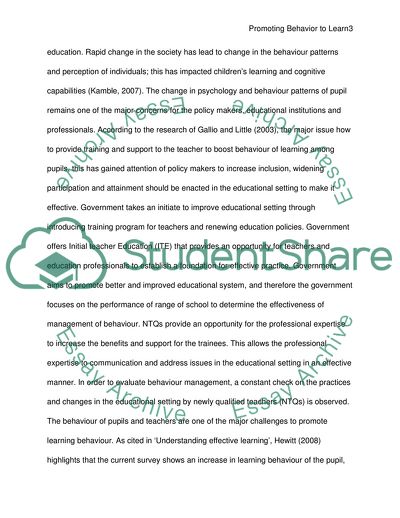Cite this document
(The Change in the Behavior of Pupils Case Study Example | Topics and Well Written Essays - 4000 words, n.d.)
The Change in the Behavior of Pupils Case Study Example | Topics and Well Written Essays - 4000 words. https://studentshare.org/education/1808900-review-and-critically-evaluate-the-implications-for-maximising-pupil-learning-in-relation-to-one-current-issue-facing-schools-promoting-behaviour-to-learn-draw-on-research-school-policy-and-practice-and-the-wider-educational-context
The Change in the Behavior of Pupils Case Study Example | Topics and Well Written Essays - 4000 words. https://studentshare.org/education/1808900-review-and-critically-evaluate-the-implications-for-maximising-pupil-learning-in-relation-to-one-current-issue-facing-schools-promoting-behaviour-to-learn-draw-on-research-school-policy-and-practice-and-the-wider-educational-context
(The Change in the Behavior of Pupils Case Study Example | Topics and Well Written Essays - 4000 Words)
The Change in the Behavior of Pupils Case Study Example | Topics and Well Written Essays - 4000 Words. https://studentshare.org/education/1808900-review-and-critically-evaluate-the-implications-for-maximising-pupil-learning-in-relation-to-one-current-issue-facing-schools-promoting-behaviour-to-learn-draw-on-research-school-policy-and-practice-and-the-wider-educational-context.
The Change in the Behavior of Pupils Case Study Example | Topics and Well Written Essays - 4000 Words. https://studentshare.org/education/1808900-review-and-critically-evaluate-the-implications-for-maximising-pupil-learning-in-relation-to-one-current-issue-facing-schools-promoting-behaviour-to-learn-draw-on-research-school-policy-and-practice-and-the-wider-educational-context.
“The Change in the Behavior of Pupils Case Study Example | Topics and Well Written Essays - 4000 Words”. https://studentshare.org/education/1808900-review-and-critically-evaluate-the-implications-for-maximising-pupil-learning-in-relation-to-one-current-issue-facing-schools-promoting-behaviour-to-learn-draw-on-research-school-policy-and-practice-and-the-wider-educational-context.


